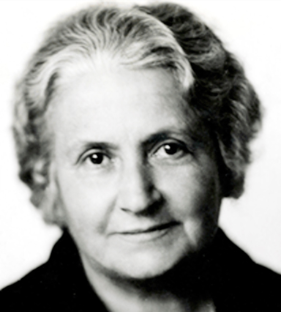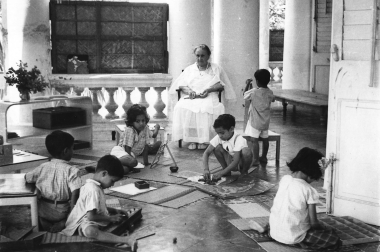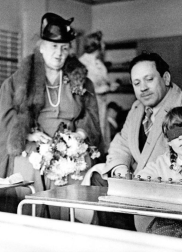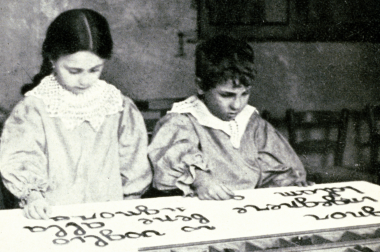Montessori Method

Montessori pedagogy is the most suitable tool for us to fulfill our pedagogical values. The essence of Montessori philosophy is that the child discovers new things and learns through their own experience, at their own pace, while working with well-designed materials. They achieve a depth of understanding and thus gain more permanent knowledge.
The main idea is that the child learns best when they are interested in the process, they enjoy it and are encouraged when they find their inner motivation to learn. The Montessori theory of education and methodology has provided us with a well-thought-out system that has been successfully applied in many countries and schools around the world for over 100 years.
The story of Maria Montessori
-
1870
Maria Montessori was born in Chiaravalle, central Italy, more than 150 years ago to the family of a senior official at the Ministry of Finance. Maria's mother came from a family that appreciated education and she was a passionate reader, which was unusual for Italian women at that time.
-
1896
Despite her father's initial opposition, Maria decided to pursue a career as a physician, and in spite of the many challenges of learning in a male dominated environment filled with social prejudices, she was the first woman in Italy to receive the title Doctor of Medicine. Soon after that, she was chosen to represent Italy at two women's conferences, in Berlin in 1896 and London in 1900, where she defended the rights of working women.

-
1900
As part of her medical practice, Maria had the opportunity to work with a group of children from a psychiatric clinic, and her observations led her to recognize that children form themselves from what they find in their surroundings. Thanks to their efforts, the children from her group passed state exams with better results than those of ordinary schools, and for the first time, her findings attracted the attention of the public.
-
1901
Maria became deeply interested in the process of children’s learning and returned to university in 1901, this time to study psychology and philosophy. In 1904 she became a professor of anthropology at the University of Rome.
-
1907
Her desire to help children was so strong that in 1906 she gave up both her place at the university and her medical practice to work with a group of sixty young children from working-class families in a very poor part of Rome. It was there that she founded the first Casa dei Bambini, or "Children's House," as she called her schools.

-
1909
In Italy, Maria found many teachers who were passionate about her method so in 1909 she began the first educational training in Rome for about 100 students. At that time, she also wrote her first book, which was soon translated into more than 20 languages. She organized further training for teacher education and founded model children's houses. Across Europe, the Montessori method began to attract supporters and quickly spread around the world. Model schools were created in the UK, France, Switzerland, Argentina and the US. On her travels, she was accompanied by her adult son, Mario, who for the rest of her life became her strong support and a promoter of the Montessori method.

-
1917
At the invitation of the Spanish Government, Maria moved to Barcelona. In Spain, she set up a training center and soon also opened educational Montessori courses in London and the Netherlands.
-
1924
Maria first met Benito Mussolini, who initially supported her method. Maria received the support of the Italian Government and funding to expand her method to all Italian schools. The cooperation that seemed advantageous at first, soon became bitter because the fascist regime did not want free choice and other basic principles of the Montessori method.
-
1933
The Nazis in Germany began mass closing of Montessori schools, and due to the incompatibility of the Montessori pedagogy principles with the fascist ideas, Maria had to leave Spain, where she was living at that time. Maria and Mario traveled to London and then to Amsterdam, which became their home for some time. In Laren, near Amsterdam, she opened another training center with a model school.
-
1940
In 1939 Maria and her son accepted an invitation to spread the Montessori method in India and spent several months there. The following year, Italy joined Germany in World War II, and the British colonial government began to treat Maria and Mario - Italian citizens - as enemies. Maria was put under house arrest and her son was taken to a detention camp - he was released only on the occasion of Maria’s 70th birthday as a gesture of respect for her.
-
1946
Maria and Mario finally managed to leave India only after the end of the war. They then returned to Europe to resume their work. In 1949, Maria was first nominated for the Nobel Peace Prize, followed by two more nominations in 1950 and 1951.
-
1952
Maria died in the Netherlands and is buried in Noordwijk aan Zee near Amsterdam.

In a Montessori system the teacher’s role is based on unobtrusive guidance and respectful help – skills that are well reflected in the famous motto of the Montessori philosophy: “Help me to do it myself”. Children always progress from the concrete to the abstract and use specially-designed materials for each area of study. These materials enable children to grasp new concepts more easily and contribute greatly to a deeper understanding and long-term retention of the new knowledge and experience gained.
Key words in Montessori education are: safety, respect, tranquility, peace, and love.
The difference between Montessori and traditional pedagogy
| Traditional pedagogy | Montessori method |
|---|---|
| Children of the same age | Mixed age groups |
| The children usually sit at their desks in school | Children can move around the class and work in different places individually or in a group |
| The teacher manages the children's activities | Children manage their activities through a prepared environment, which supports their acceptance of their own responsibility for the learning process |
| Focused on the result, using tests and school grades | Focused on the process, the use of formative assessment, without using marks and comparing children |
| The emphasis is on comparison and competitiveness | The emphasis is on cooperation |
| Children learn in class, where they all work on the same subject and assignment at the same time | Children learn in blocks of so-called uninterrupted Montessori cycles, connecting objects, children manage their activities and choose the work and time |
| Learning based on meeting the standard and outcomes of the grades | Query and discovery based learning |
| The teacher gives instructions to the whole class or group of children on the basis of a predetermined curriculum and their growth is focused on the area and outcomes of the given year | Teachers plan individual lessons, children use specific teaching materials independently, learn from each other and have the opportunity to grow based on their own potential |
Principles of Montessori pedagogy
Learning through self-discovery
The learning process is based on a child’s self-discovery and his/her active approach to work which is encouraged by the child’s desire to know and his/her intrinsic need to learn and understand the world around him/her.
Montessori guides
The teacher guides the child through his/her learning process: he or she helps the child whenever needed, respects his/her individual pace of development, and proceeds in accordance with the child’s sensitive periods which reflect the child’s natural "readiness" to acquire certain knowledge and skills.
Prepared Environment
Both in terms of the materials and the teacher’s personality and human relationships (between the teacher and the children; among the children) is of essential importance for the learning process to be effective.
Freedom of Choicey
At a given time the child can choose his/her work, working space (within the classroom) and a person he/she wants to work with. However, the freedom of choice does not mean that the child moves from one activity to another without finishing it or that he/she does not work at all. The freedom does not imply that the child is left alone or that the teacher does not intervene in the child’s learning process at all. There is always an activity the child must choose to do. The teacher coordinates the activities of all children in the class and must use his or her professional skills to help each child, without commands and orders, to find an activity that the child will find interesting.
A child’s freedom is, of course, considered a responsibility, not an act of anarchy. This means that when a child decides to work on something, it is his/her obligation to complete this work. When the child wants to work with a material of his/her interest – and of their own choice - it is also his/her responsibility to adhere to the given rules.
Personal responsibility
The teacher lets the child choose freely from the given range of activities, but at the same time he or she helps the child to prioritize or to choose a preferred activity if the child cannot decide alone. The child is thus given the freedom of choice to the extent of his/her ability to assume responsibility. The teacher intervenes whenever he or she sees the child is bored, is not able to choose an activity or is breaking the rules. In addition, the teacher supports and helps children who need help. The teacher’s goal is to guide the child step by step towards a sense of their own responsibility.


Polarization of Attention
Children look for an activity that appeals to them most, immerse themselves into it, and become totally engaged with it. The teacher allows them to continue with their work as long as they stay focused, he/she does not interrupt them and gives them enough time (In fact, all possible barriers which could hinder the process are eliminated from the school and the classrooms: e.g. the classes are not divided into particular lessons by the traditional sound of a “school bell” – instead, children are quite flexible in the use of their study time).
Control of Error
Children are not punished or negatively evaluated for making mistakes; they should rather view them as indicators of what still needs to be practiced or revised. The error is seen as a natural occurrence in the learning process, as a useful part of problem-solving, and as a rich source of new knowledge. The teachers should not use negative evaluation – instead, they should, for example, offer the child the same material again so that the child has the opportunity to understand his/her own mistakes and to self-correct them. All the materials are designed in a way that the child is always able to check his/her answers and to find and correct any possible mistake on his/her own -mistakes therefore help children in their further study.
Rewards and Praise
The relationship between an adult and a child in the Montessori system requires a loving approach of the adult (i.e. the teacher) to each child. The teachers try to use language in such a way that they can avoid any words of judgment but at the same time acknowledge the child and the new knowledge he/she has acquired, or show sympathy and concern. All children need to feel safe, secure and successful; they need to know they are being noticed, and they need to experience feelings of joy and satisfaction from their work. A continuous positive or negative evaluation from an adult, however, hinders the process of a free choice of activities and influences the child’s self-esteem. Our aim is for children to do what gives them a feeling of inner satisfaction. The child is appreciated only to such an extent that he/she does not become dependent on external praise. The child should feel self-satisfaction from the work he/she does; they do not do the work to meet the needs or wishes of an adult, to be praised or to get good grades (that is why our school only uses verbal evaluation). The praise is used mainly with new and insecure children to make them feel more safe and secure.

Peace and Tranquility
Children learn how to calm their body as well as their mind and use this state of calmness to focus on their work more deeply. In the classroom, all children (as well as teachers) are encouraged to express themselves as quietly as possible; when addressing someone, a child should behave in a way that he/she does not disturb the others, etc.
Mixed-Age Classes
In each class, children from 2 or 3 different grades work together (grades 1 to 3 and 4 to 5). The environment promotes collaboration and communication. Older children love to take care of the younger ones and to teach them – which is an activity that in turn improves their skills. In a class of children of the same age a child with a slight difference may feel out of place; in a mixed-age class, diversity becomes an advantage which also promotes the principle of no competition between children and provides each child with a safe and secure place for their individual development.